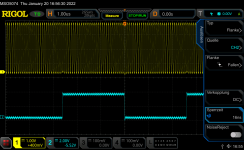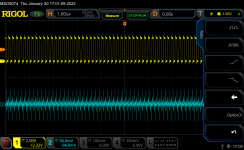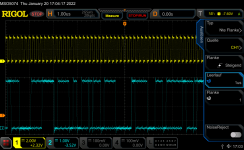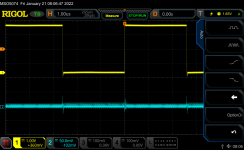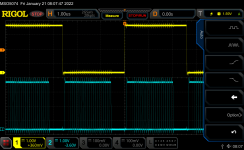Alternatively, you could try piggybacking 2 pcs of AD1862 per channel to use the original D1 i/v stage values. I am using the D1 i/v in my implementation and the AD1862 dac sounds fabulous with the values I indicated above. Note that I have not measured the same.
I am also using the original D1 i/v values for the PCM56 boards, where 2 pcs of PCM56 are piggybacked and they also sound very good.
In many respects, I prefer the sound of the PCM56 dacs because of the perceived warmth they exude, when playing music. But the sound quality is not limited to just warmth; there is an element of continuousness in the sound that seems more organic and less hifi ish. I am surprised that apart from me and one other forum member, nobody else seems to have tried out the PCM56 dacs. Try them and I am sure, you will not regret it; given that PCM56 dacs are still readily available online on Ali express for example and are relatively cheap in comparison with the AD1862 dacs. The PCM56 are excellent sounding chips when implemented as NOS.
Mind you, these is just my personal opinion. I dont have golden ears nor do I profess any expertise in judging the sound of hifi equipment; but I do know what I like. So it may be a case of one man's meat is another man's poison.
Incidentally, when implementing the D1 i/v, I have found that different output caps have a significant influence on the sound. Not so much the values, but different brands. Polyester and polystyrene caps sound very clear and transparent, but at the expense of weight in comparison with metallised polyproylene caps.
Just my 2 cents worth
I am also using the original D1 i/v values for the PCM56 boards, where 2 pcs of PCM56 are piggybacked and they also sound very good.
In many respects, I prefer the sound of the PCM56 dacs because of the perceived warmth they exude, when playing music. But the sound quality is not limited to just warmth; there is an element of continuousness in the sound that seems more organic and less hifi ish. I am surprised that apart from me and one other forum member, nobody else seems to have tried out the PCM56 dacs. Try them and I am sure, you will not regret it; given that PCM56 dacs are still readily available online on Ali express for example and are relatively cheap in comparison with the AD1862 dacs. The PCM56 are excellent sounding chips when implemented as NOS.
Mind you, these is just my personal opinion. I dont have golden ears nor do I profess any expertise in judging the sound of hifi equipment; but I do know what I like. So it may be a case of one man's meat is another man's poison.
Incidentally, when implementing the D1 i/v, I have found that different output caps have a significant influence on the sound. Not so much the values, but different brands. Polyester and polystyrene caps sound very clear and transparent, but at the expense of weight in comparison with metallised polyproylene caps.
Just my 2 cents worth
It´s a four chanel scope with a I2S measuring feature. You´ll need at least a 3 chanels setup.I hope you will find the solution soon. Because you are so close to nice sounding DAC
How many digital inputs can be measured by your scope?
But I have only two probes

I have to buy better USB cable AND probes...
@mllum ... you are correct 😁
The original values provide on the output 2.3Vpp with 2mA input.
3k + 6k6 (3 x 2k2 for R5, R6, R7) provide 2.15Vpp with 1mA input.
3k3 + 9k9 (3 x 3k3 for R5, R6, R7 or one 10k) provide 2.48Vpp with 1mA input.
You are one from two guys who built the PCM56 version and tested it
The original values provide on the output 2.3Vpp with 2mA input.
3k + 6k6 (3 x 2k2 for R5, R6, R7) provide 2.15Vpp with 1mA input.
3k3 + 9k9 (3 x 3k3 for R5, R6, R7 or one 10k) provide 2.48Vpp with 1mA input.
You are one from two guys who built the PCM56 version and tested it

@baggerbole You are fine with 2 probes. Measure all signals with respect to BCK (on the same time scale) and post the measurement here 🙂
BCK + LRCK
BCK + DL
BCK + DR
measure it unplugged from DAC, just pure I2SoverUSB board (make sure GND is well connected)
BCK + LRCK
BCK + DL
BCK + DR
measure it unplugged from DAC, just pure I2SoverUSB board (make sure GND is well connected)
Brilliant thankyou. Any benefit of 3 x R in series to create the 6k6, why not just one 6k6R and 2 jumpers?
mllum... I did. It concours what I think from a long time...tda1541A, AD1862 (prefer it over the pcm63) and pcm56 are for me the best podium dac chips.
Excellent testimonial, indeed caps choice matter as other details.
RCORE if well made adds softness without details loss.
All the decoupling choice around the dac chip and I/V choice helps a lot to voice it.
Of course the I/V stage typology and the choice of the regs circuitry, the smoothing cap choice.... I/V resistor choice in relation with others choices, etc.
All of that pays off but asks a llt of work most of the time designers and brands do not thinking theory and sims are enough.I can make two same boards sounds tottaly different just with a caps work... easy to make one sounding not so good...
Excellent testimonial, indeed caps choice matter as other details.
RCORE if well made adds softness without details loss.
All the decoupling choice around the dac chip and I/V choice helps a lot to voice it.
Of course the I/V stage typology and the choice of the regs circuitry, the smoothing cap choice.... I/V resistor choice in relation with others choices, etc.
All of that pays off but asks a llt of work most of the time designers and brands do not thinking theory and sims are enough.I can make two same boards sounds tottaly different just with a caps work... easy to make one sounding not so good...
BCK is always yellow trace@baggerbole You are fine with 2 probes. Measure all signals with respect to BCK (on the same time scale) and post the measurement here 🙂
BCK + LRCK
BCK + DL
BCK + DR
Looks like DL is flat...
Attachments
I assume you sent music or a sine wave through it. Is the configuration is as in your post #3225?
DL looks flat 😳 ... Can you add measurements LRCK_DR and LRCK_DL?
Your scope has 16 digital inputs (inputs great for this measurement). Do you have cable for it? It should be the rectangle connector with many pins.
DL looks flat 😳 ... Can you add measurements LRCK_DR and LRCK_DL?
Your scope has 16 digital inputs (inputs great for this measurement). Do you have cable for it? It should be the rectangle connector with many pins.
Knowing diddly squat about IV resistors, but hopefully learning fast......is the relationship between the drain and source resistors a strict one or can they deviate a bit.
For instance can I go 3k and 6.8k?
For instance can I go 3k and 6.8k?
Yes, that’s what I would do. Simply increase the volume control setting to get the same loudness level. If building the D1, that is the simplest way to address the reduced I/V signal voltage, so long as your preamp then has sufficient excess gain (most likely, it does) to compensate for the reduced signal amplitude out of the D1, as driven by the AD1862.That makes sense even to me but I would have no clue how to change that....and I'm not asking for a solution here dont worry.!
Gives me some homework to do.
Maybe I just turn the volume up some more or use with a higher gain pre amp.?!
A 1V output signal is enough for 99 % of amp or pre...and often the pots work beter at twelve o clock position 🙂
... less is better here and not only because of the lower distorsion. However if you directly drive a headphones it might be a different story according the model
... less is better here and not only because of the lower distorsion. However if you directly drive a headphones it might be a different story according the model
Jim,
I would agree with Ken and Iggy here, try building the D1 as per schematic and give it a spin. You might be pleasantly surprised with the useable amount of volume control with the twist of the dial. If you have a stout preamp that you use with a follower amplifier, use that.
I would agree with Ken and Iggy here, try building the D1 as per schematic and give it a spin. You might be pleasantly surprised with the useable amount of volume control with the twist of the dial. If you have a stout preamp that you use with a follower amplifier, use that.
Piling on ... you probably have enough gain. I've built my DACs with a 1k5 IV resistor which is supposed to give 1.5Vpp, using a B1 Korg preamp with 16dB of gain which is low versus most commercial preamps. I typically listen with the volume at about 50% and it gets too loud well before I run out of volume knob.
Yes I sent music trough. I´ve changed the config from #3225 to #618 as Vunce advised.I assume you sent music or a sine wave through it. Is the configuration is as in your post #3225?
DL looks flat 😳 ... Can you add measurements LRCK_DR and LRCK_DL?
Your scope has 16 digital inputs (inputs great for this measurement). Do you have cable for it? It should be the rectangle connector with many pins.
Config is now:
J1-J4 open
B1-B3 closed
B4-B6 open
DR = H3:9
DL = H3:13
BCLK(BCK) = H3:11
LRCK = H3:15
Power connected via USB at H3:17 and H3:19
The scope is new to me. It's like EXCEL or WORD, it can do quite a lot and you use a maximum of 10 percent of it 😉
I don´t have the wire harness for the dig in port.
I have inquired with JLsounds but have not received an answer yet.
Attachments
@baggerbole first go back to config from post #3225 since you are not using shift registers. I think this is J2 open, J3 open, J4 closed. B1 to B5 all open. Then if it was me who knows even less about scopes and measurements I would first measure signals coming out of i2soverusb board directly on output pins of i2soverusb board.Yes I sent music trough. I´ve changed the config from #3225 to #618 as Vunce advised.
Config is now:
J1-J4 open
B1-B3 closed
B4-B6 open
DR = H3:9
DL = H3:13
BCLK(BCK) = H3:11
LRCK = H3:15
Power connected via USB at H3:17 and H3:19
The scope is new to me. It's like EXCEL or WORD, it can do quite a lot and you use a maximum of 10 percent of it 😉
I don´t have the wire harness for the dig in port.
I have inquired with JLsounds but have not received an answer yet.
If everything on that side is OK I would move to DAC board and measure signals coming to DAC.
Ref; D1 IV
Thanks for all the additional info everyone.
I have a Salas DCG3 set to 2x and that feeds a 7293 power amp at the moment. I did lower the gain of the pre from 3 to 2 a while back so I could always revisit that.
I was going to build a couple of these up anyway so I'll probably try both R set ups, and one with the onboard 317/337 psu and one probably with a Ubib.
Anyone know anything about C27 and C17? They have asterisks on the schematic but they aren't referenced to a value. Maybe optional.?!
Paddy your 2 box build looks mega. Great idea of using 2 x PSU1, one for rectifying and one for regulation in the other chassis.
Thanks for all the additional info everyone.
I have a Salas DCG3 set to 2x and that feeds a 7293 power amp at the moment. I did lower the gain of the pre from 3 to 2 a while back so I could always revisit that.
I was going to build a couple of these up anyway so I'll probably try both R set ups, and one with the onboard 317/337 psu and one probably with a Ubib.
Anyone know anything about C27 and C17? They have asterisks on the schematic but they aren't referenced to a value. Maybe optional.?!
Paddy your 2 box build looks mega. Great idea of using 2 x PSU1, one for rectifying and one for regulation in the other chassis.
- Home
- Source & Line
- Digital Line Level
- DAC AD1862: Almost THT, I2S input, NOS, R-2R

